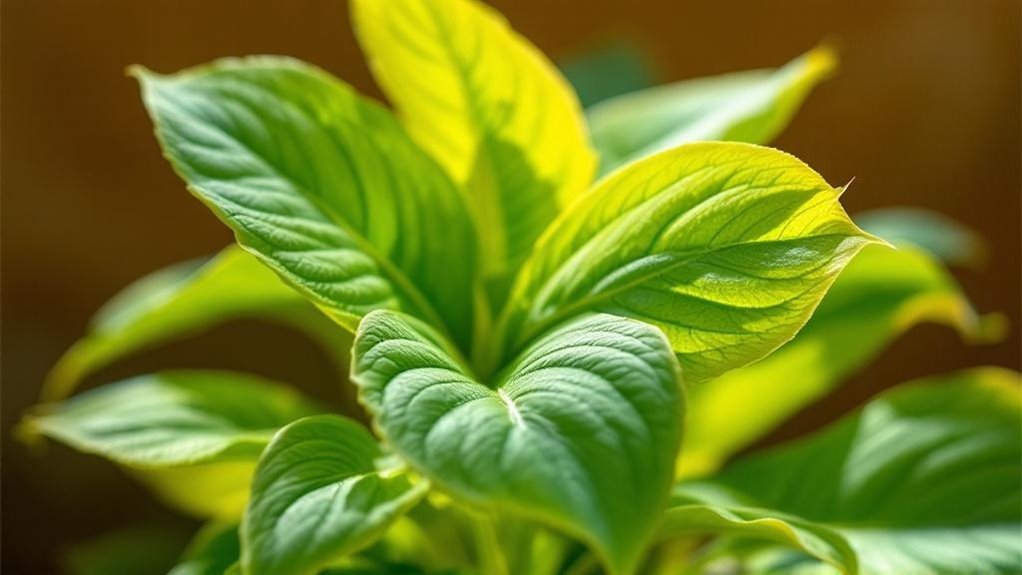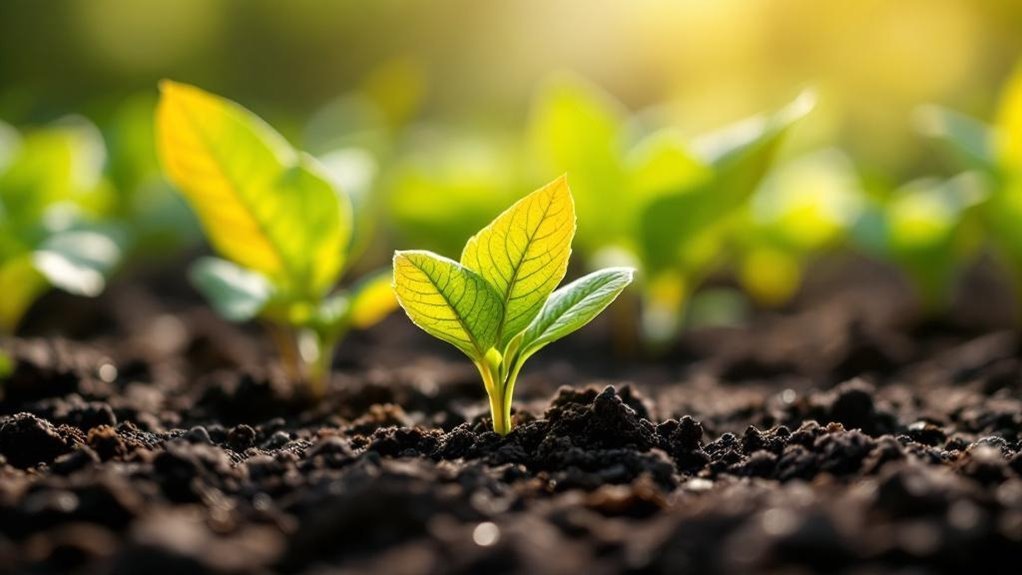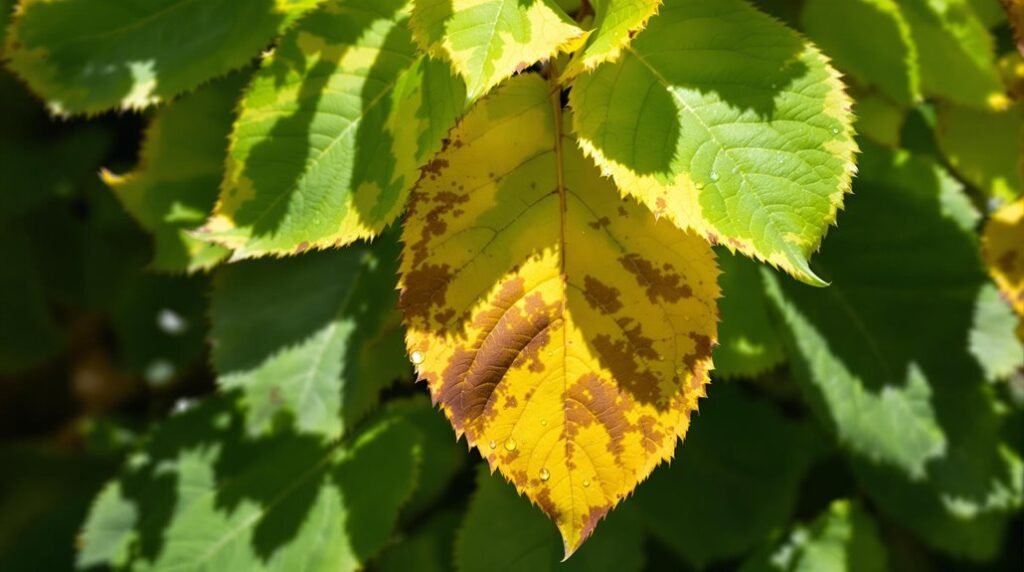You might not realize that yellowing leaves starting at the bottom often point to specific nutrient issues rather than just general plant stress. It’s not always about watering or light—sometimes, the problem lies deeper with soil chemistry or root health. Understanding these subtle signs can help you pinpoint the cause more accurately. Before you decide on a fix, consider the factors that might be silently affecting your plant’s color from the roots up.
Common Causes of Yellowing Leaves From the Bottom
When you notice yellowing leaves starting from the bottom, it often signals that your plant is facing nutrient deficiencies, especially a lack of nitrogen. This nutrient deficiency causes the plant to divert resources to new growth, leaving the older leaves yellowing and weakening.
Lower leaves are typically the first to show signs because nutrient uptake becomes less efficient with age. Soil pH plays an essential role too; if it’s too high or too low, your plant can’t absorb nutrients properly, leading to yellowing.
While overwatering can contribute to root rot, which suffocates roots and disrupts nutrient uptake, this topic will be explored later. Compacted or damaged roots also reduce nutrient flow, causing yellowing from the bottom up and threatening overall plant health.
Identifying Overwatering Symptoms and Solutions
Yellowing leaves can also point to overwatering, especially if the discoloration starts with the lower leaves. Overwatering drowns roots, depriving them of oxygen, which causes yellowing and wilted leaves.
To identify overwatering symptoms, check for:
- Wet, muddy soil and excess moisture around roots.
- Wilted, soft leaves that feel limp.
- Presence of fungus gnats indicating overly damp conditions.
To fix overwatering, let the soil dry completely before watering again.
Perform the finger test by inserting your finger into the soil to gauge moisture levels. If roots show signs of rot, repotting in fresh, well-draining soil is crucial to restore proper drainage and revive the plant.
Monitoring soil moisture closely will help prevent yellowing leaves caused by overwatering in the future.
Signs and Remedies for Underwatering

Although underwatering can be easy to overlook, you’ll notice signs like leaves curling inward, dry soil, and brown edges on older foliage. Yellow leaves often appear from the bottom up as your plant struggles for moisture.
To remedy underwatering, thoroughly saturate the soil until water drains from the bottom, ensuring the roots get adequate moisture. Check soil moisture regularly by inserting your finger up to the first knuckle; if it feels dry, it’s time to water.
Soil compaction can block water absorption, so gently aerate the soil to improve drainage and circulation. Acting quickly helps your plant recover faster, though some may take days to bounce back.
Keep an eye on these signs to maintain healthy roots and vibrant leaves.
Nutrient Deficiencies Linked to Yellowing Leaves
If your plant’s leaves start turning yellow from the bottom up, you might be dealing with a nutrient deficiency, with nitrogen often being the main culprit.
Yellowing happens because plants divert crucial nutrients to new growth, sacrificing older leaves. To tackle nutrient deficiencies, focus on these key signs:
Plants prioritize new growth by moving nutrients away from older leaves, leading to yellowing as a clear deficiency sign.
- Nitrogen deficiency causes uniform yellowing of older leaves.
- Potassium deficiency shows yellowing at leaf edges, sometimes with curling or browning.
- Magnesium deficiency creates yellow patches between leaf veins, giving a mottled look.
Using balanced plant foods can replenish vital nutrients.
Since soil pH affects nutrient availability, regularly testing your soil guarantees you catch deficiencies early.
Paying attention to these factors helps keep your plants healthy and prevents further yellowing on leaves turning pale from nutrient stress.
The Role of Soil Ph in Leaf Discoloration

Because soil pH directly affects how well your plant absorbs nutrients, maintaining a balanced pH is crucial to prevent leaf discoloration.
If the soil pH is too acidic or alkaline, it can lock out critical nutrients like nitrogen, potassium, and magnesium, causing yellowing leaves due to nutrient deficiencies.
To keep feeding your plants effective, regularly test the soil pH and adjust it accordingly—add lime to raise pH or sulfur to lower it.
Proper drainage holes also help maintain soil conditions favorable for nutrient uptake.
Root Health and Its Impact on Leaf Color
When your plant’s roots struggle to absorb water and nutrients, you’ll notice yellowing leaves signaling distress.
Root health directly affects nutrient delivery, and damaged or compacted roots can’t support healthy leaf color. Overwatering often leads to root rot, suffocating roots and causing yellowing leaves from the bottom up.
Damaged or compacted roots hinder nutrient delivery, often causing yellowing leaves starting from the bottom.
You can check root health during transplanting; blackened or mushy roots reveal oxygen deprivation and poor nutrient uptake.
To improve root health and restore leaf color, follow these steps:
- Inspect roots for signs of rot or compaction.
- Repot using fresh, well-draining soil to prevent overwatering issues.
- Choose a larger pot to ease stress on your plant’s roots.
Maintaining healthy root systems is key to preventing further yellowing leaves.
Preventative Care to Maintain Healthy Leaf Color
To keep your plant’s leaves vibrant and healthy, you need to adopt consistent preventative care practices.
Regularly check soil moisture with the finger test to avoid overwatering or underwatering, common causes of yellowing leaves. Use well-draining potting soil to support healthy root growth and prevent soil compaction.
Implement a balanced fertilization schedule by applying quality plant food, ensuring your plant receives crucial nutrients. Maintain soil pH between 6.0 and 7.0 to optimize nutrient availability and avoid toxicity.
Promote good air circulation and provide appropriate lighting conditions to reduce plant stress. Together, these steps help prevent yellowing, keeping your plant lush and vibrant.
Frequently Asked Questions
Why Are the Leaves on My Plant Turning Yellow From the Bottom Up?
Your plant’s bottom leaves turn yellow because it might lack nutrients like nitrogen, suffer from overwatering or underwatering, or experience pH imbalance. Check soil moisture and pH to pinpoint and fix the problem quickly.
Why Are My Plants’ Leaves Dying From the Bottom Up?
Did you know over 70% of plant issues stem from improper watering? Your plants’ leaves are dying from the bottom up because they’re likely stressed—check watering habits, soil nutrients, and root health to help them recover quickly.
What Deficiency Makes Leaves Turn Yellow?
You’re likely dealing with a nitrogen deficiency if older leaves turn yellow first, as your plant moves nutrients to new growth. Potassium, magnesium, or iron deficiencies cause different yellowing patterns, so check leaf location and symptoms carefully.
What Do Yellowing Leaves Indicate?
Yellowing leaves often signal stress, such as nutrient shortages, soggy soil, or severe sun exposure. You’ll want to check watering habits, soil health, and light levels to spot the source and save your struggling greenery.
Final Thoughts
Think of your plant as a living story, where each yellowing leaf is a whispered chapter of its needs. When leaves yellow from the bottom up, it’s like a signal flare, guiding you to check soil health, watering habits, and nutrients. By tuning into these signs and adjusting care—like a gardener tending a delicate manuscript—you’ll help your plant rewrite its story with vibrant green pages, ensuring it thrives and flourishes chapter after chapter.
